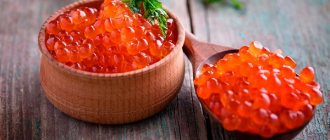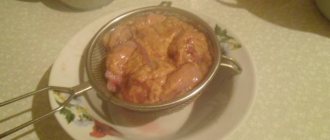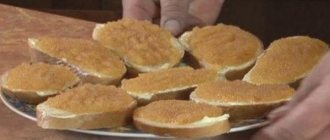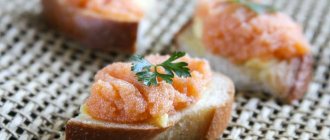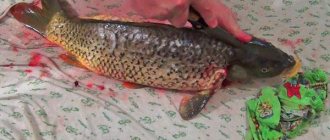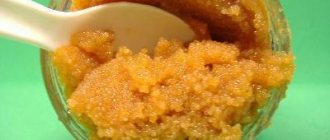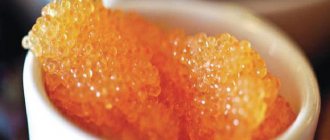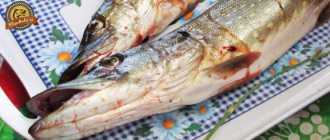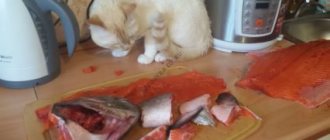v 8 915
Did you buy trout with caviar? A pleasant addition can be very easily pickled, in just a few hours you will get a real delicacy, very tasty and healthy! And without preservatives and chemicals. What is the best way to pickle trout caviar at home?
Preparing caviar
Before salting caviar at home, you need to properly prepare it - remove the film called yastyk. This can be done in several ways.
- You need to take a piece of gauze and fold it in several layers to make a “sleeve”. Close one side and place trout eggs there. When it is clean, rinse thoroughly.
- A more complex but effective method is cleaning in brine. You need to boil water and add salt to it at the rate of 3 tablespoons per 1 liter of water. Pour the main product with this brine and cover the dish tightly with a lid. “It is important that the brine is not very hot. To check this, you need to throw a few eggs into the liquid, and if they do not lose color, the brine is suitable. You should also not rinse with cold liquid, otherwise the caviar will become hard and rubbery.” Leave the trout eggs in the brine for 20 minutes. During this time, the yastyk will become loose and soft. Next, take a fork and beat them very carefully, with smooth movements in one direction, for several minutes. This way, the trout grains will remain intact, and the film will break. Place the delicacy on a sieve to drain all the brine. Place parts of trout eggs on napkins and gently wipe with clean napkins on top.
- You can try to clean it manually - break the film and carefully remove the grains.
Secrets of perfect pickling
Salt in salting caviar is the main ingredient of the recipe. It is recommended to use table or sea salt, excluding iodized salt. Not only the taste of a lightly or salty product and shelf life depend on the amount of spice, but also the ability to kill germs and helminths. This means it is safe for consumption. But, if the caviar was over-salted, you should immerse it in warm water for 4-5 minutes, and then be sure to dry it.
You can extend the shelf life of home-salted caviar by freezing it. If the refrigerator expires, place the jar in the freezer.
Well-cooked brine at the cooking stage will also keep it fresh longer.
Frozen caviar requires proper defrosting before serving: 10-12 hours in the refrigerator before leaving at room temperature. Do not rush to defrost, otherwise the eggs may burst.
It is very important to maintain the correct temperature of the brine—+50. To avoid the eggs dissolving in it. It is worth checking with your finger, which should not be burned in the liquid.
It is better to use purified water for brine.
Vegetable oil at the final stage will make the eggs crumbly and shiny.
Glass jars for storing caviar are hygienic utensils. They do not absorb odor and do not emit sending substances.
Separating the eggs from the film with a whisk does not require any special skill. The jar floating in the liquid is stirred with a tool, making rotating movements in one direction for 3-4 minutes and in the other. The shell and veins will wrap around it.
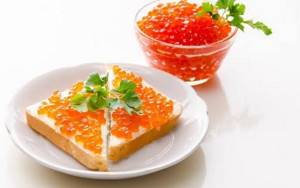
Simple and fast
The following recipe calls for the same ingredients.
- Release the red caviar from the egg using a sieve.
- Transfer the trout eggs into a suitable container and cover them with a mixture of salt and sugar in a 2:1 ratio.
- Stir everything carefully and cover with a lid.
- Pour the product into cheesecloth for a while.
- Place the trout eggs in the prepared bowl. The caviar comes out quite salty and is perfect for various culinary masterpieces.
The total number of proteins is 120, fats – 85, carbohydrates – 26, calories – 1349.
Cooking time – 4.5 hours.
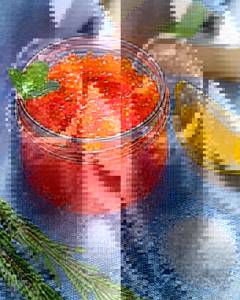
How to salt trout caviar at home for long-term storage
Fish products are advised to be eaten quickly, without keeping them for a long time. Even smoked meats, because they spoil.
Most recipes require quick consumption of the snack (2-3 days). The only option for salting trout caviar is to freeze it in the freezer. What is dry salting suitable for?
Ingredients:
- • trout caviar – 1 kg;
- • salt – 30 gr.;
- • sugar – 10 gr.
Preparation:
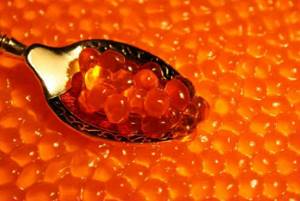
- Mix spices together.
- Transfer the caviar (as is, without cleaning) into a deep glass container.
- Add spice mixture.
- Cover with a plate (lid), place a weight on top. A mug filled with plain water will do.
- Salting time is 3-5 hours. If desired, you can rinse it in a separate lightly salted solution, removing excess salt.
- Transfer the finished product into small sterilized containers for subsequent storage.
Consume after defrosting (if you place the product in the freezer).
Ask the chef! Didn't manage to cook the dish? Don't be shy, ask me personally.Go
Far Eastern way
The following recipe will require a variety of ingredients:
- 0.5 kg red caviar
- 2-3 cloves of garlic
- 50 g soy sauce
- 50 g sesame oil
- Red pepper (to taste)
- Lemon juice (to taste)
It will take about 30 minutes to prepare the products, including cleaning the caviar in any way and rinsing it in water.
Cooking steps:
- Pass the peeled garlic through a garlic press, prepare the brine, mixing everything thoroughly with water.
- Pour the resulting sauce over the trout eggs and leave to steep for about 15 minutes.
The total number of proteins is 124.2, fats are 135.1, carbohydrates are 28.2, calories are 1824.
Cooking time – 50 minutes.
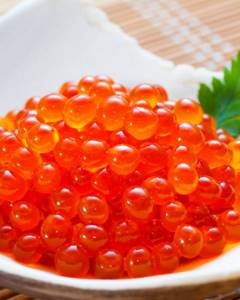
With lemon
Salting trout caviar with lemon at home is also not difficult, and the taste is amazing. You will need:
- Caviar – 150 g
- Half a lemon
- Salt – 2 heaped spoons
- Sugar – 1 spoon
- Vegetable oil – 2 tablespoons
- Water – 0.6 liters
Preparing the food will take 12 minutes.
- Squeeze lemon juice in any convenient way. The seeds and pulp are removed, the zest is used for further preparation.
- Boil the lemon peels in water for three minutes, then add sugar and salt and cook for a couple more minutes. Then cool the liquid to 50 degrees.
- Immerse the grains in the resulting brine, add lemon juice and salt for 15 minutes.
- Pour vegetable oil over the finished dish.
The total number of proteins is 36.9, fats – 59.5, carbohydrates – 9.6, calories – 716.1. Cooking time – 40 minutes.
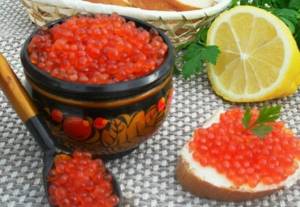
How to choose caviar for pickling
The high quality of the product is indicated by its original color and smell. First of all, we determine the freshness of the caviar. It can be easily identified by the fresh smell of the fish itself. If the fish is fresh, the caviar extracted from it will be closer in color to orange than to red. The egg with caviar should have a fresh fishy smell.
After salting, the caviar will change its appearance and turn from pale orange to bright red due to the action of salt. Caviar extracted from fish can be stored in the refrigerator for no more than a day. After salting, the shelf life of the finished product increases depending on the chosen cooking recipe.
To make the right choice, minimal knowledge about the types of caviar will be useful.
- The roe is salted together with the roe (in film). Due to the caviar, its taste is bitter, and when prepared, it resembles caviar from salted herring. The product prepared in the oven is stored for no longer than a month.
- Pressed caviar is salted in a factory by pressing. After pressing, the consistency of the delicacy is pate-like. To obtain this type of canned product, unripe trout caviar is often used. Canned food is stored in hermetically sealed jars for more than a year and has a specific taste.
- Granular caviar is obtained from mature trout eggs. The classic cooking process is the simplest and fastest. After freeing the caviar from the film, the eggs are separated from one another and oil and salt are added to the cleaned translucent grains. Caviar prepared in the traditional way has an excellent taste, is juicy and does not taste bitter. The classic recipe is used to prepare granular caviar at home.
Spicy Ambassador
Salting trout caviar in a spicy way is also an excellent aromatic option, and the fishy smell and taste will remain just as rich. It takes half an hour to prepare the products. The ingredients needed are:
- Red caviar – 150 g
- Water - half a liter
- Salt – 40 g
- Sugar – 15 g
- Allspice – 3 pcs.
- Dried ground ginger – 1 pinch
- Half a bay leaf
- Cloves – 1 pc.
Cooking steps:
- Boil water with salt, sugar and spices for 5 minutes. Cool under the lid to 45-40 degrees. This will make the water fragrant.
- Pour brine over the cleaned caviar, mix everything carefully and leave for 15 minutes.
After the time has passed, carefully transfer the product to a sieve or cheesecloth for a while.
Cooking time – 40 minutes.
The total number of proteins is 36.2, fats – 26.2, carbohydrates – 9.6, calories – 418.6.
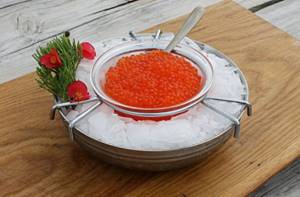
How to pickle trout caviar in a spicy way
A variant of a very aromatic and spicy brine for caviar. No, the product will not lose its fishy taste and smell, but will become more aromatic and noble.
Ingredients
- 0.5 liters of water;
- 40 g salt;
- 15 g sugar;
- 3 peppercorns;
- 1 pinch of ginger;
- 0.5 bay leaf;
- 1 clove.
Preparation
- Boil water with salt and sugar in a saucepan for about five minutes, add all the spices and immediately turn off. The ginger is ground and dry. If you have a fresh root, you can take that too.
- Let the marinade cool under the lid so that all the aromatic substances are absorbed into the water.
- We filter the brine, it is desirable that it has a temperature of around 45-50 degrees.
- Immerse the caviar. For this amount of brine, 100-150 grams is enough, stir thoroughly and leave for a quarter of an hour.
- Pour into a sieve, try not to damage the eggs, you can cover with gauze. Dry for 10 minutes.
- Transfer to a jar and place in the refrigerator for a couple of hours.
In brine
How to pickle trout caviar without cleaning it first? You can use the following recipe. The main point is that the brine should be salty enough. Preparation of ingredients – 10 minutes. Need to purchase:
- 800 g red caviar
- 700 g of iodized salt (you can take 350 g of iodized table salt and 350 g of sea salt)
- 50 g sugar
- 1 liter of water
Spices to taste
- Pour water into a bowl, add salt, sugar and all the spices.
- Bring the liquid to a boil over medium heat, stirring occasionally. “It’s quite simple to check how high the concentration of brine is - just put in an egg or one potato. If the products float to the surface, then the brine is ready.” Cool the prepared brine solution to 55 degrees.
- Transfer the unrefined product to the brine and, gently stirring with a whisk, wait until the film is completely separated.
When the trout eggs get rid of the egg, keep them in the brine for 15-20 minutes so that they are completely soaked. If you leave for 5-8 minutes, the trout grains will turn out lightly salted, very tasty and will be stored for 5 days (it is better to eat within 3 days). “If you salt it longer, the product can be stored for a week. Lightly salted grains taste better, but it is still better to salt them longer. This is necessary in order to remove all possible harmful microorganisms.”
“It is not the amount of salt that is important, but the holding time. If you suddenly overexposed caviar in a salty solution, you need to keep it in clean boiled water for several minutes.”
- Place in a stack.
- Transfer the dried caviar into a clean container and leave for a day; you can use it earlier).
Cooking time – at least an hour.
The total number of proteins is 192, fats – 136, carbohydrates – 81.5, calories – 2318.
“If this delicacy is not eaten within two days, it should be frozen in small parts. After defrosting, caviar can be used for various dishes."
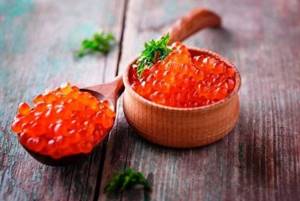
How to pickle trout caviar - general principles
Any fish caviar is suitable for salting: sea, river, fresh, frozen. Naturally, the better the quality of the original product, the better the result. Among all the salting methods, dry and wet are distinguished, that is, the product is simply sprinkled with salt, or it is prepared with the addition of liquid.
Not only the taste, but also the shelf life of caviar depends on the chosen recipe. But in any case, it is advisable not to store homemade preparations for a long time, consume them while they are as fresh and healthy as possible.
It is recommended to store trout caviar salted at home in the refrigerator for no more than 75 days.
Methods for cleaning caviar
Before salting trout caviar, the product must be freed from the protective film. Manual selection of eggs is immediately eliminated, as it is time-consuming, painstaking, and tedious.
Cleaning methods:
- Marley. Roll up a large piece of gauze into 4 layers. We place the caviar in the central part. We lower the gauze into a basin or pan with warm water and begin to rotate. Gradually the film will come off, the pieces will remain on the gauze. The method is convenient, uncomplicated, but lengthy and time consuming.
- Hot. Relatively fast way. The caviar is poured with hot water for a few seconds. All films come away from the balls. The disadvantage of this method is the need to select pieces from the product.
- Massage. A neat, but also quite long and painstaking method. The egg is cut in half or into 3 parts, the eggs are carefully pulled out.
- Whisk. The oyster is torn in several places, the caviar is poured with warm water, the whisk is immersed and the product is stirred. Gradually, films will be wound around the rim. Then the caviar is poured into a sieve, and the remaining roe is removed by hand.
Each method has its own advantages and disadvantages. Choose the one that is most convenient for you.
With soy sauce
To salt caviar with soy sauce, you will need:
- 350 g fresh caviar
- 2 tablespoons salt
- 4 tablespoons soy sauce
- 1 teaspoon coriander
- 1 teaspoon ground allspice
- 1 teaspoon dried basil
The solution is prepared in the standard way - sauce, salt and spices are mixed with water. After the solution has infused, you need to pour the main product over it and let it brew for 15 minutes.
Total number of proteins - 88.8, fats - 60, carbohydrates - 23, calories - 985. Cooking time - 40 minutes.
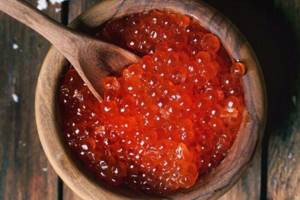
In sugar and salt
Salting using only sugar and salt is also possible. The taste of the delicacy is simply excellent. To prepare according to the proposed option, you need:
- 500 g trout caviar
- 70 g salt
- 35 g sugar
- 1 liter of water
- Clean and dry red caviar thoroughly.
- To prepare the brine, it is better to boil the water. But if you plan to consume the delicacy right away, you can do without boiling and immediately dissolve the salt and water in the liquid.
- Pour the main product into a pan and add brine - you should get more of it. Leave for 15 minutes.
- Stretch a thin layer of gauze over the dishes, the ends of which must be tied to the handles.
- Pour the liquid through cheesecloth until it drains completely. It will take about 10 minutes.
Total number of proteins – 120, fats – 85, carbohydrates – 55, calories – 1464. Cooking time 45 minutes.
Fish selection
Fish with caviar purchased at the market or in a supermarket is considered a good purchase. Caviar prepared at home is natural, better than store-bought caviar, it has no preservatives, is lightly salted, juicy and smells of the freshness of the sea. The carcass of pink salmon and trout fish has its own characteristics characteristic of the salmon fish breed, and if you take them into account, you can choose a seafood product that is ideal for salting fish and caviar. Before you buy the right one, take a closer look at it.
- The simplest sign of freshness of a fish carcass is red gills. Gray color indicates low quality product.
- Fresh female fish is the most suitable option. Females, unlike males, have a wide back and a thick belly, indicating the presence of caviar in the fish.
- The freshness of the carcass itself is manifested in the bright silver color of the skin without a yellow coating.
To make a real seafood delicacy yourself at home, you need to peel the caviar from the film.



